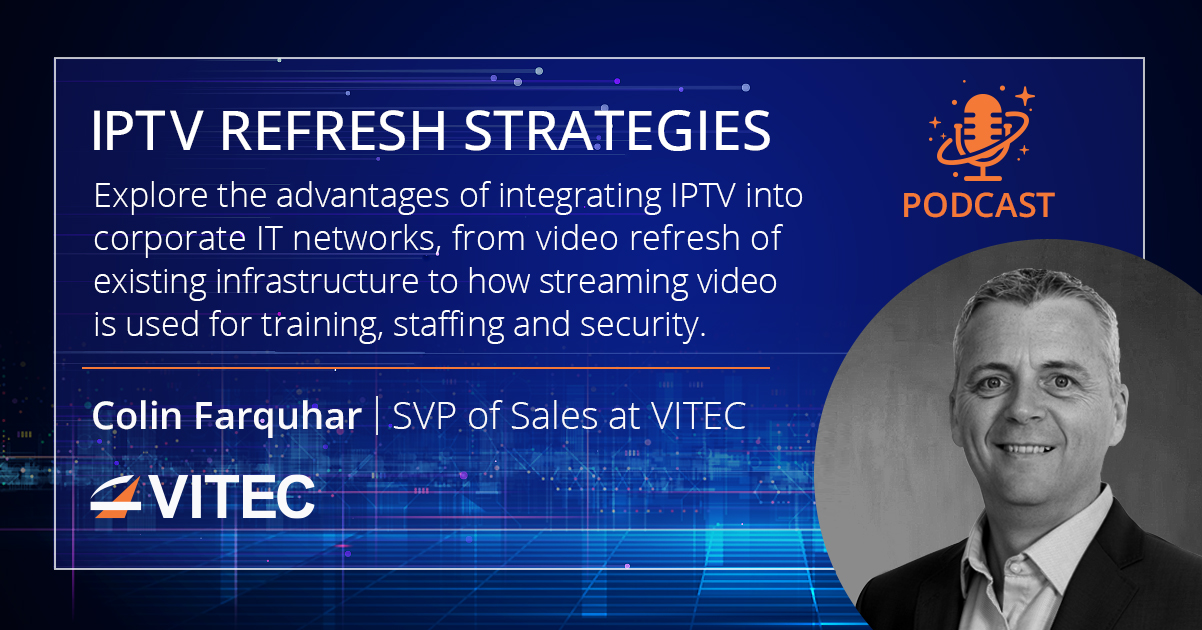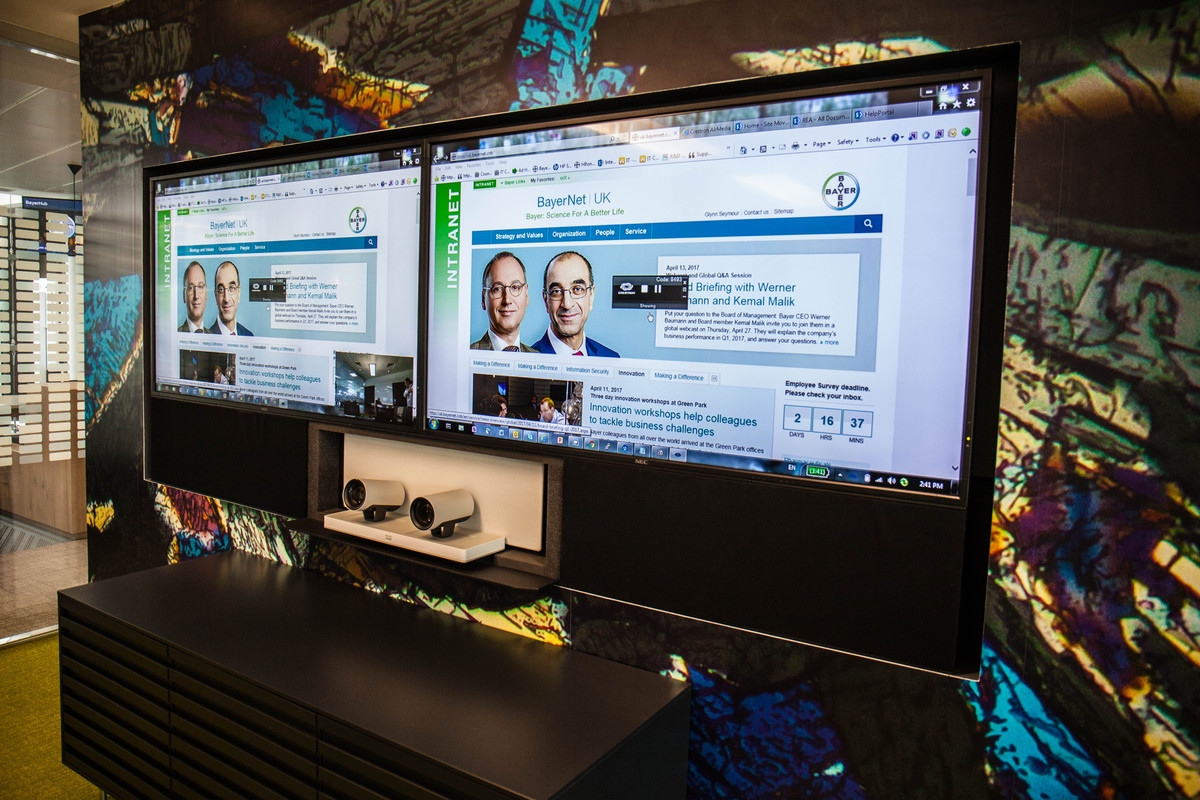
Over the past two decades, video applications in the enterprise have emerged as a mainstream technology supporting the achievement of mission-critical organizational objectives. Once reserved for the largest organizations that could afford to allocate resources for dedicated RF video infrastructures, the emergence of IPTV has democratized access to video as a critical enterprise resource.
Indeed, IPTV has been around long enough that we see two sets of major technology refresh initiatives in the market. Organizations that still retain legacy RF video technologies are moving to brand new IPTV environments as early adopters of IPTV strategies modernize their existing investments.
To better understand the nuances of the enterprise video refresh environment, we caught up with Colin Farquhar, senior vice president of sales at VITEC — a leading provider of advanced video encoding and streaming solutions for business, industrial and public sector applications.

› Listen: “IPTV Refresh Strategies”
Q While video has been around for a long time, it looks like we are entering a new era of business video applications. How is this affecting the way IT leaders plan for this traffic to flow through enterprise networks?
Colin Farquhar: Video content has always been important, driven mainly by the desire to communicate efficiently within organisations. The types of technologies used for this communication have varied quite dramatically. When we think of traditional video content, we typically think about live television originally distributed over coax cable infrastructures.
While this approach was pretty straightforward, within organisational facilities, it was often ‘upgraded’ to include some internal channels that offered content specific to the company or the facility. For the most part, it was an adequate solution…and all that was available at the time. But it was pretty clear to leaders that it did not offer a lot of flexibility for delivering content to screens throughout a corporate workspace/building. It was a dedicated infrastructure that delivered content to dedicated terminals—TV screens.
As demand for video content continued to grow, the limitations of coax cable became apparent. Having a computer screen and a dedicated TV on a desktop was not convenient–or practical. This is why we saw the initial demand for enterprise-class internet-protocol television (IPTV) begin to manifest itself.
About a decade and a half ago, we saw the first wave of organisations move away from separate dedicated RF video infrastructures to IPTV that integrated video traffic into the enterprise network. For those that made the transition, the outcome was very successful. They saved organisations a lot of money and freed up resources to engage in value-added activities.

Source: Video application case study
Thomson Reuters employees keep in touch with the world from their desktops with VITEC IPTV solution
There is, however, still a significant number of organisations that—for many reasons—have not, until now, made the move to enterprise IPTV. But that is beginning to change. In fact, today we find the market is going through a bifurcated set of enterprise video infrastructure refresh initiatives.
- As leaders assess aging RF video infrastructures, few find a compelling case to stay with the legacy technology. This is prompting interest in what IPTV has to offer as they open new facilities or rip-and-replace existing video infrastructure.
- Organisations that transitioned to IPTV over the past couple of decades are now moving to a new generation of technologies that offer higher levels of performance, intelligence and security. The good news for this category is that making the transition to the latest capabilities will be able to leverage investments that have already been made in IPTV. It doesn’t necessarily require a complete overhaul.
Another easy transition is to incorporate IPTV, which allows businesses to take greater advantage of the content available to them—including but not limited to content from a wide range of sources, like TV content, self-created educational content, and virtual signage, just to name a few. This essentially takes screens from being a simple playout point for video to a visual experience geared towards enhancing employee and customer experience.
QCan IPTV meet people’s high fidelity expectations around video experiences in enterprise environments?
Farquhar: Yes. In fact, one of the significant advantages of introducing first-generation IPTV to organizations revolved around the ability to deliver high-quality video to any point in the building with no delays or buffering.
This is in stark contrast to RF networks, where quality depended on how far an amplifier was from the screen displaying content, how many connections were on the cable and how many people were trying to view the content at the same time.
IPTV has emerged as a proven high-performance solution that delivers a consistent digital bit stream of content to any terminal across the enterprise network. This is a huge advantage—and one of the reasons many companies are keen to transition to IPTV.
Moreover, we have seen remarkable improvements and innovation in the IPTV space. The technology has evolved dramatically over the years, ensuring the delivery of more content efficiently over more networks.
Today video content has exploded to be one of the most consumed content. According to a BTR-100 survey commissioned by VITEC, 93% of enterprise technology executives surveyed report that video traffic in their organization is growing because of end-user demand, with 85% indicating that video traffic on enterprise networks contributes to the achievement of important organizational objectives.
In short, businesses are now tasked with delivering vast amounts of material across infrastructures. Doing so optimally has become the number one priority, and video is emerging as the key to meeting this requirement.

Source: Video application case study
Bayer UK Headquarters builds innovative collaborative spaces with state-of-the-art VITEC IP Video
Q What are the new best practices—or attributes—that organisations should consider when they begin their refresh process?
Farquhar: In my opinion, there are four critical areas that enterprises should be considering as they begin their refresh process.
- The way the organisation will use video content. Leaders must clearly understand the broad array of use-cases that need to be supported by asking questions such as: Are we generating a lot of employee-generated content? Are we streaming programming from outside of the organization? What are the digital signage requirements? Are we upgrading existing facilities, moving into new offices or building a new corporate campus? We review and discuss these questions with our clients all the time to ensure that we have a clear understanding of the desired future state the organization wants to achieve and the role that IPTV can play in supporting that business transformation.
- The existing infrastructure and what new technologies should be included in the refreshed networks. There has never been a more exciting time for enterprise video. The technologies today are more sophisticated, intelligent and intuitive than ever. There is no shortage of options and features that can be potentially included. The key is to understand what exactly to include as organizations design more sophisticated networks that support a wider variety of devices and content over wireless and hard-wired networks.
- Correct training/staffing. This is an often overlooked aspect of a successful refresh strategy. In many ways, the rising use of video technology contributes to how corporate culture is defined and developed. It is a competency that needs to be consciously developed and nurtured. It is becoming as important as using word processors and spreadsheets. It is extremely important that organizations adequately hire and train staff so they can efficiently and effectively activate video content across the various business objectives.
- Security. This goes without saying. The threat landscape has never been more severe. As we refresh investments in video technology, it is critical to ensure that we are not opening any doors to bad actors. Indeed, the industry must integrate security practices and considerations into every aspect of the design, development and deployment process. And after deployment, we must ensure that the ongoing management of enterprise video resources is executed with the protection of data, applications and personal information at the top of mind.
These are the principles that guide the way VITEC brings IPTV solutions to market. It provides a structure for how we engage with clients and suppliers as we work collaboratively to bring value to markets. They are as critical in greenfield solutions—where we introduce IPTV applications for the first time—as they are in refresh initiatives, where we convert RF networks and upgrade previous investments in IPTV technology.
Video application case study
Thomson Reuters employees keep in touch with the world from their desktops with VITEC IPTV solution
Thomson Reuters Case Study
VITEC IPTV case study
Bayer UK Headquarters builds innovative collaborative spaces with state-of-the-art VITEC IP Video
Bayer UK



